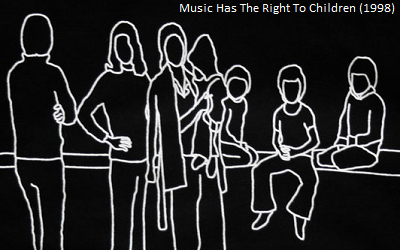
What can be said about Boards of Canada’s debut album that hasn’t been said already? For many, it is a gateway to the archetypal sound of the Internet. For others, it is a collection of songs and sounds which seem to have always existed in some form- and to claim that they did not exist prior to 1998 would be ludicrous, even sacrilegious.
Music Has The Right To Children’s influence cannot be understated- not only is it considered one of the best albums from electronic music’s golden age, a time when new releases by the likes of Aphex Twin, Daft Punk, and Fatboy Slim were hitting record store shelves and selling out in the millions, it’s also a formative piece of Rollerwave- if not canonically Rollerwave itself, it is undeniable that it affected the sound of Rollerwave going on into the modern period.
Its status as true Rollerwave is debated by aficionados of the genre. Some claim that Dan Frost invented Rollerwave with the release of “To Every Man”. Some claim other influences in the early years of the genre. Some praise BOC as the innovators. Much like with vaporwave, who first did it is less clear than it may seem at a cursory glance. We once assumed by default that Daniel Lopatin was vaporwave’s founding father- only to then be reminded of the massive impact hypnagogic pop and chillwave had on the genre. The same applies to Rollerwave- when dealing with an ethereal medium that relies on distorted memory, it’s only fitting that the medium’s history is choppy and contentious.
Many have said that listening to Boards Of Canada is a transitory experience, that their songs call to mind a nonexistent time and place, an anachronous past, a childhood that will never be recaptured. These descriptions are apt, yet in terms of BOC’s overall aesthetic, where does your mind drift to the most, what decade comes to mind first? That’s right- out of every promotional image, album cover, and photo the duo have ever released, they all look like the 1970s.
MHTRTC is a cohesive arrangement, in that each piece follows a strict theme and an adherence to the aforementioned aesthetic. It’s easily BOC’s most listenable work, catchy and repeatable. Every hook is precise, each chord bursts with color and personality. It’s no wonder that, tired of the cheap-sounding futuristic noise electronic music claims to offer, consumers were immediately drawn to the album’s old-fashioned, halcyon sensibilities- a reminder that electronic music is not inherently futuristic, that it’s merely another means of conveying a message to the listener, and any message can be conveyed, whether that be futuristic or retrospective.
It’s the sort of album which demands close attention and must be heard in one sitting- while less story-oriented than Tomorrow’s Harvest or Geogaddi, it nonetheless is an experience where the sum of all these songs together is greater than their individual components. Hearing these in order, with Wildlife Analysis at the beginning and One Very Important Thought at the end, is pivotal in understanding what electronic music can achieve if handled properly.
Not much else need be said about MHTRTC that hasn’t already been said in countless music articles across the Internet which don’t concern Rollerwave and don’t focus specifically on the influence BOC have on Rollerwave, and I’d suggest looking at those if you want to conduct more research on your own terms. While I don’t personally consider it to be BOC’s best album, I do think it’s BOC’s most appealing album, in that nearly everyone can find something to love about it. Just know that, if you haven’t heard it already (which is statistically improbable) you’re very lucky to go into it with fresh ears. See your initial listening session as a privilege.